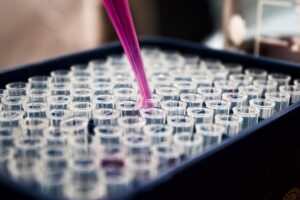8 Ways Life Science Laboratories Are Reducing Their Carbon Footprint
 Climate change affects every industry. Life science researchers are reducing their carbon footprint by changing how they work in their laboratories. Learn more about the primary strategies for minimizing their environmental impact and how labs can implement them to achieve the same results.
Climate change affects every industry. Life science researchers are reducing their carbon footprint by changing how they work in their laboratories. Learn more about the primary strategies for minimizing their environmental impact and how labs can implement them to achieve the same results.
1. Reduced Electricity Use
Using minimal electricity is a key way laboratories are reducing their carbon footprint. Research shows 60% of U.S. energy currently comes from fossil fuels. If labs used less electricity, they would help cut back on overall fossil fuel usage and benefit the environment.
Experts estimate that clinical laboratories can reduce their energy usage by 30%-50%, regardless of their research or daily use. Strategies like ensuring freezer doors seal shut and cleaning condenser coils will maintain energy efficiency.
Scheduling routine HVAC ventilation inspections and cleanings prevents the AC and heating units from working harder to keep labs at the same temperature. Teams can also reduce the temperature of thermocyclers and water baths at night when possible.
2. Work From Home Opportunities
While some life sciences work must happen in approved laboratory settings, other researchers can work from home. They might participate in video calls with others in the lab or work on paperwork from the comfort of their living rooms. Cutting out some of their commuting time reduces their individual fossil fuel consumption, shrinking the carbon footprint of their labs.
Shifting to hybrid schedules may also make hiring easier. Research shows that 39% of people aged 25-34 want full-time remote work, which includes college graduates in the life sciences sector. Although completely remote work may not be possible for researchers, hybrid schedules could appeal to more job applicants and fill much-needed positions on research teams.
3. Photovoltaic Panels
People often picture solar panels when they imagine reducing their environmental impact, but photovoltaic panels are another option for life science laboratories. They attach to rooftops and collect thermal energy or heat. The photovoltaic absorbers turn the heat into electricity. Comparatively, solar panels capture only solar radiation.
Photovoltaic panels are excellent resources for life science laboratories in warm climates. They could power a lab year-round if the fall and winter temperatures stay mild. Any excess electricity would bank in the local power grid or an on-site battery for days when cold weather prevents the panels from generating power.
4. Bio-Based Pipet Tips
Various laboratory liquids need different pipet tips. They’re essential for preventing aerosol contamination, reaching deeper into test tubes and handling volatile liquids. Single-use tips help researchers avoid mixing the wrong liquids or affecting other experiments, but the tiny tips end up in landfills that harm the environment.
Bio-based pipet tips are a significant resource for life science laboratories in reducing their carbon footprint. Manufacturers transform recycled ingredients into polypropylene instead of using crude oil to make traditional plastic.
Cooking oil waste and bio-based kitchen residue currently make up 90% of recycled pipette tips and could become 100% of the manufacturing process in the coming years. They’ll naturally biodegrade when they reach landfills or composting centers, preventing cross-contamination in labs without resources requiring fossil fuels or unsustainable materials.
5. Virtual Conferences
Biotech, pharma and clinical conferences happen globally throughout the year. Attendees burn fossil fuels for mainstream travel methods, except for individuals with eco-friendly cars. Some people may also skip essential conferences if their global-warming anxiety makes them physically ill at the thought of long-distance travel. Virtual events would solve this issue and more.
People wouldn’t have to use fossil fuels to attend essential events, allowing them to learn from their peers and present their own research without harming the planet. Given that a life scientist’s estimated annual carbon footprint can reach 15 tons of CO2, every opportunity to reduce that planetary harm benefits the environment.
Attendees could also use digital resources instead of printed materials that would otherwise remove vital trees from ecosystems. Lab researchers would shrink their individual carbon footprint, ultimately making their laboratory success greener.
6. Eco-Friendly Cleaning Supplies
Pipette tips are recycled and energy-efficient lab equipment is available, but cleaning supplies are a hidden issue in life science laboratories. They use strong chemicals to clean surfaces and equipment thoroughly. It’s necessary for lab safety, but they eventually harm the planet when they reach the outdoor world.
Cleaning chemicals wash down sink drains and reach local waterways, polluting the nearby environment. Paper towels carrying the chemicals also carry them to landfills. Swapping those paper-based supplies with cloth towels reduces the single-use waste, but the chemicals still reach waterways. Biodegradable cleaning solutions would make a laboratory much greener without compromising the cleanliness of supplies and surfaces.
7. Shared Equipment
Labs can have different purposes but use identical equipment. When possible, nearby or regional teams can keep in touch to share unused equipment like cell culture dishes, plates or beakers. Borrowing supplies when possible reduces the transport and shipments that otherwise burn fossil fuels.
Manufacturing such supplies also adds to a lab’s carbon footprint. Glass used in beakers, test tubes and other resources requires melting sand. Sand use is rising 6% globally each year, which United Nations Environment Programme (UNEP) experts say is unsustainable. The planet would run out of sand if that escalation continues.
Reusing or sharing glass equipment means laboratory staff don’t make purchases requiring more of the limited resource. It’s a simple strategy that makes any lab greener.
8. Strategized Machine Operations
Equipment like dishwashers, sterilizing ovens and autoclaves are essential for laboratory research. Although Energy Start-certified alternatives could be a future investment, running the machines less often makes them greener right away. Researchers should only run them when they’re full to maximize the efficiency of their electricity usage. It leads to less frequent cycles and less energy consumption per laboratory.
Reduce Carbon Footprints in the Life Sciences
Laboratories are reducing their carbon footprint in numerous ways. It requires rethinking current practices and shifting perspectives, but it’s not impossible. Researchers can use these ideas to make their work more eco-friendly. Recycled pipette tips, shared equipment and remote conferencing are just a few ways to start green transformations in the life science field.


